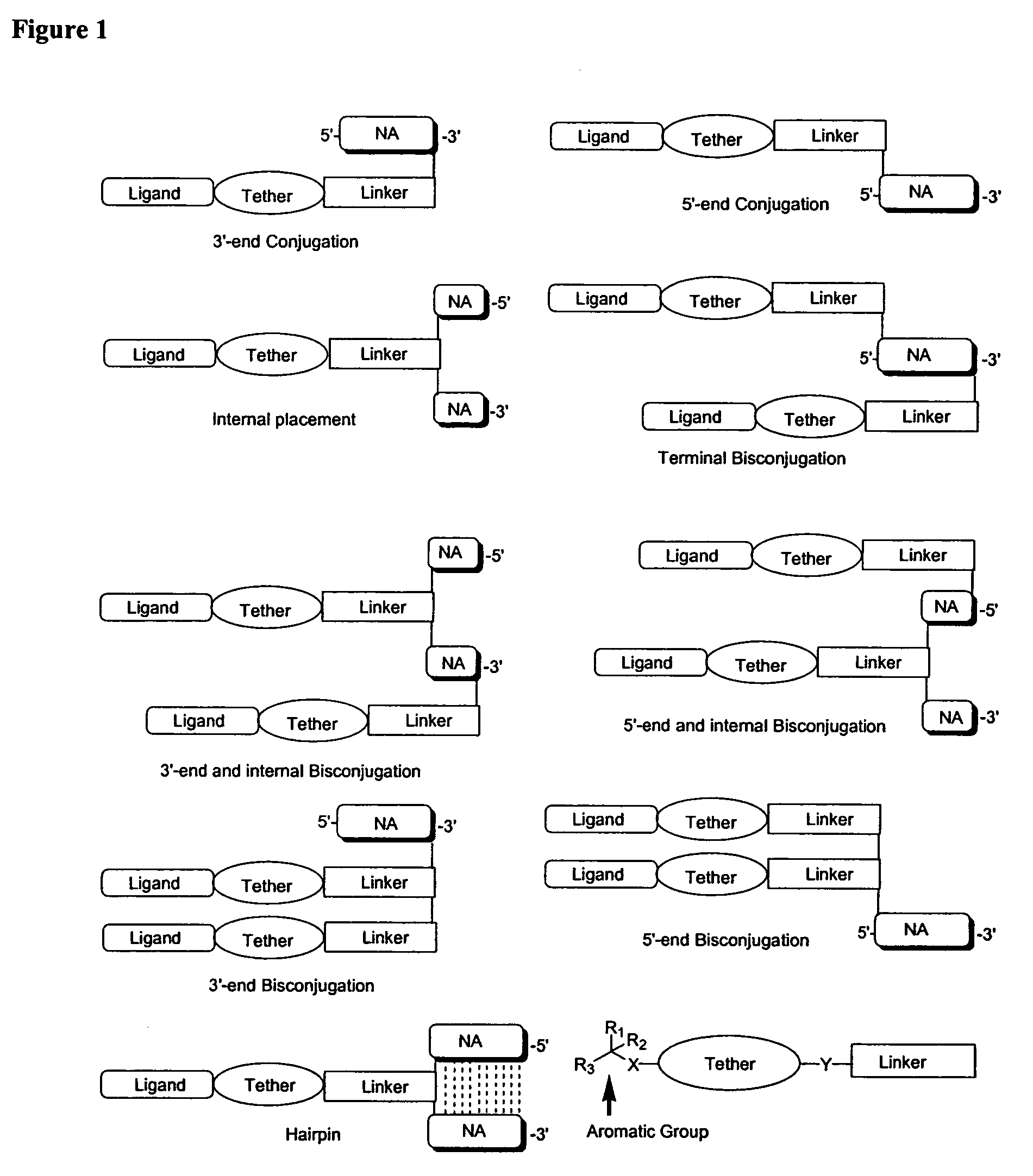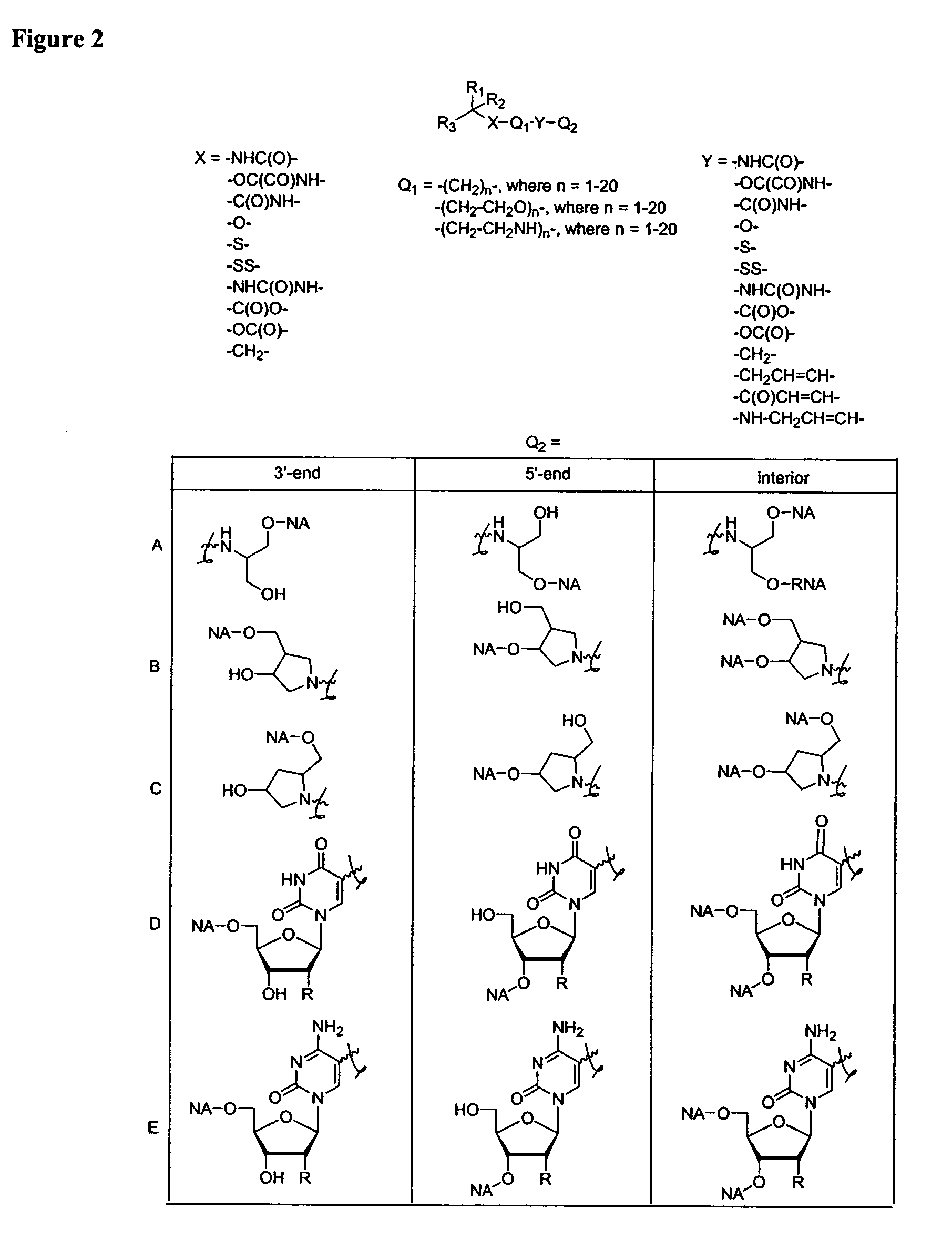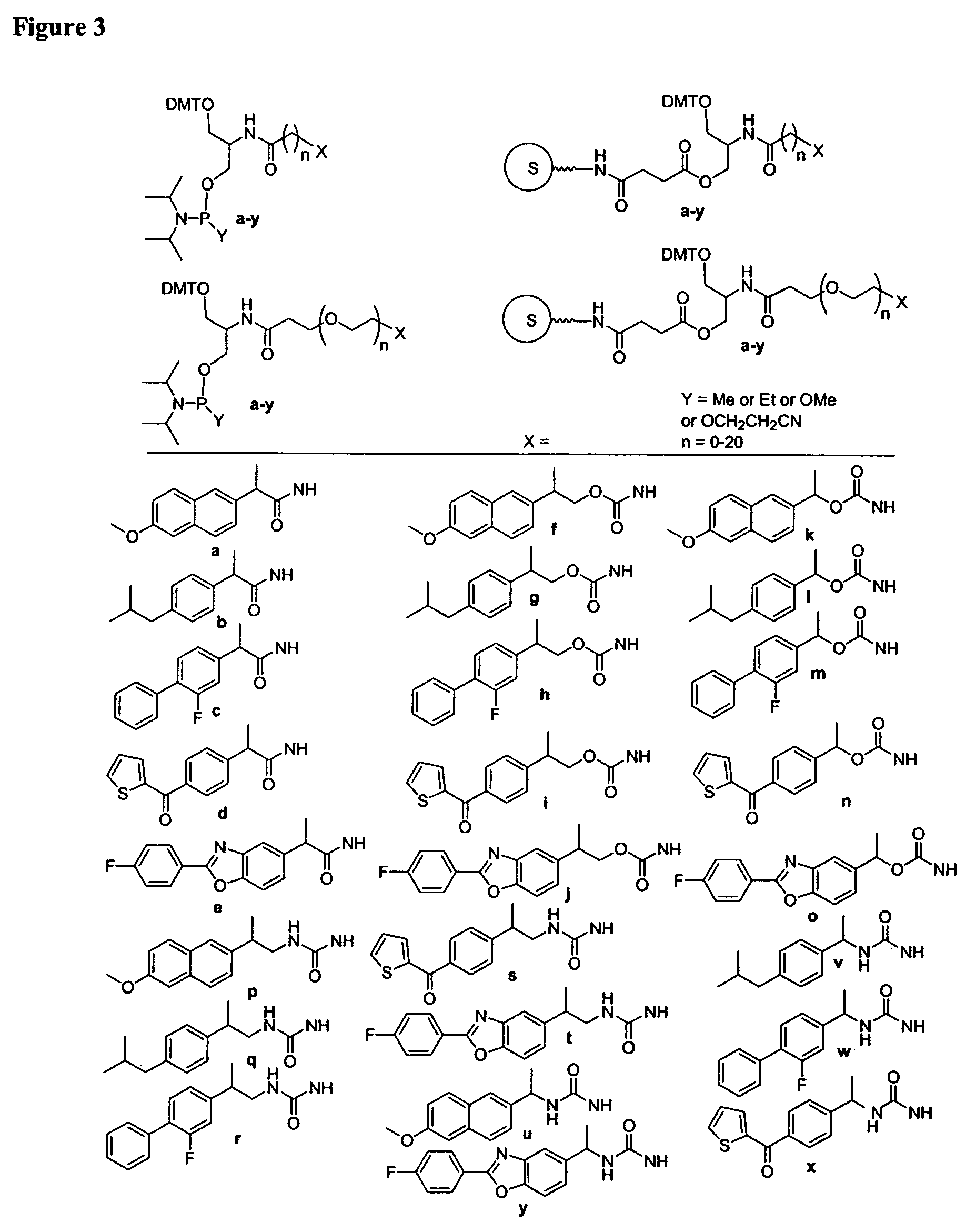Oligonucleotides comprising a non-phosphate backbone linkage
a non-phosphate backbone and oligonucleotide technology, applied in the field of oligonucleotides comprising a non-phosphate backbone linkage, can solve the problems of poor serum solubility of oligonucleotide sequences, poor cellular distribution and uptake, and rapid excretion, etc., to achieve the effect of facilitating cellular uptake and reducing the number of oligonucleotide sequences
- Summary
- Abstract
- Description
- Claims
- Application Information
AI Technical Summary
Problems solved by technology
Method used
Image
Examples
example 1
Monomer Synthesis
[0869]
a (i) X—P(Cl)—N(iPr)2, TEA / dichloromethane or X—P—[N(iPr)2]2, tetrazole / tetrazole-diisopropylammonium salt / MeCN; or X—P(Cl2), one eq. HN(iPr)2 followed by one 1 eq. 1 in MeCN / dichloromethane.
Synthesis of Methylphosphonamidite [2, R=OTBDMS, X=Me, B=Adenine (N-bz); Cytosine (N—Ac); 5-Methylcytosine (N-Bz); Uracil; 5-Methyluracil; Guanine (N-iBu); or Inosine, Scheme 1):
Method 1
[0870]Appropriately base protected 5′-O-DMT-2′-O-TBDS-nucleoside (adenosine, guanosine, cytidine, 5-methylcytidine, uridine, 5-methyluridine or inosine) purchased from ChemGenes Corporation, 33 Industrial Way, Wilmington, Mass. is reacted with 1.2 equivalent of chloro-N,N-diisopropylaminomethylphosphine (obtained from from ChemGenes Corporation, 33 Industrial Way, Wilmington, Mass.) in anhydrous dichloromethane (or THF) containing 3.0 equivalent of diisopropylethylamine to obtain a diastereomeric mixture of the desired methylphosphonamidite 2 as reported by Sinha et al. (Nucleic Acids Res.,...
example 2
Synthesis of Isopropylphosphonamidite [2, R=H, OTBDMS or OMe, X=Isopropyl, B=Adenine (N-bz); Cytosine (N—Ac); 5-Methylcytosine (N-Bz); Uracil; 5-Methyluracil; Guanine (N-iBu); or Inosine, Scheme 1):
[0874]Isopropyldichlorophosphine (purchased from Aldrich) is reacted with one equivalent of anhydrous diisopropylamine (purchased from Aldrich) in dichloromethane containing three equivalent of diisopropylethylamine. To the resulting reaction mixture one equivalent of the appropriately protected nucleoside is added under constant stirring at ambient temperature. The diastereomeric mixture of the desired isopropylphosphonamidite after standard workup is purified by flash silica gel column chromatography to obtain pure compound 2 (Vaghefi et al., Nucleic Acids Res., 1995, 23, 3600).
[0875]5′-O-DMT-2′-deoxy-thymidine-3′-O—(P-isopropyl)phosohonamidite: To a solution of i-Pr2NH (0.31 ml) in dry CH3CN (4 mL) at −20° C. was added dichloroisopropylphosphine (11 uL) and stirred at the same temperat...
example 3
Synthesis of tert-Butylphosphonamidite [2, R=H, OTBDMS or OMe, X=tert-Butyl, B=Adenine (N-bz); Cytosine (N—Ac); 5-Methylcytosine (N-Bz); Uracil; 5-Methyluracil; Guanine (N-iBu); or Inosine, Scheme 1):
[0876]tert-Butyldichlorophosphine (purchased from Aldrich) is reacted with one equivalent of anhydrous diisopropylamine (purchased from Aldrich) in dichloromethane containing three equivalent of diisopropylethylamine. To the resulting reaction mixture one equivalent of the appropriately protected nucleoside is added under constant stirring at ambient temperature. The diastereomeric mixture of the desired tert-butylphosphonamidite after standard workup is purified by flash silicagel column chromatography to obtain pure compound 2 (Vaghefi et al., Nucleic Acids Res., 1995, 23, 3600).
[0877]5′-O-DMT-2′-deoxy-thymidine-3′-O-(E-tert-butyl)phosphonamidite: To a solution of i-Pr2NH (6.17 ml) in dry CH3CN (50 mL) at −20° C. was added tert-butyldichlorophosphine (3.0 g) and stirred at −20 to 0° C...
PUM
| Property | Measurement | Unit |
|---|---|---|
| diameter | aaaaa | aaaaa |
| diameter | aaaaa | aaaaa |
| diameter | aaaaa | aaaaa |
Abstract
Description
Claims
Application Information
 Login to View More
Login to View More - R&D
- Intellectual Property
- Life Sciences
- Materials
- Tech Scout
- Unparalleled Data Quality
- Higher Quality Content
- 60% Fewer Hallucinations
Browse by: Latest US Patents, China's latest patents, Technical Efficacy Thesaurus, Application Domain, Technology Topic, Popular Technical Reports.
© 2025 PatSnap. All rights reserved.Legal|Privacy policy|Modern Slavery Act Transparency Statement|Sitemap|About US| Contact US: help@patsnap.com



